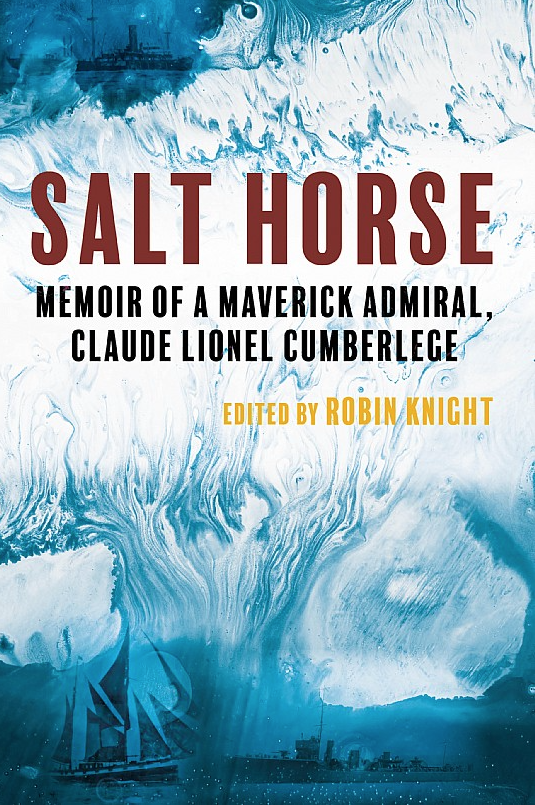
Salt Horse: Memoir of a Maverick Admiral, Claude Lionel Cumberlege. Edited by Robin Knight, Whittles Publishing, Dunbeath, 2024.
Reviewed by Perter Jones & David Stevens
A fine seaman with abundant common sense, Rear Admiral Claude Lionel Cumberledge (1877-1962) transferred to the RAN in 1913 as a loan officer having already commanded no fewer than nine warships and a destroyer division in the Royal Navy. Thereafter he not only commanded the RAN’s destroyer flotilla, but also the cruisers Encounter and Brisbane on active service then later became Fleet Captain in Australia and Melbourne during their time as flagships.
Indeed, he remained in seagoing commands throughout his eight years with the RAN, becoming the post-war fleet’s most experienced ship’s captain with service on the Australia, China, East Indies and Mediterranean Stations. Among his many wartime achievements were the first night reconnaissance into German-held Blanche Bay during the Australian occupation of Rabaul in September 1914, the first operation of an aircraft from an Australian warship during the hunt for the German raider Wolf in May 1917 and commanding the combined Allied force that occupied Smyrna in Turkey in December 1918.
The publication of Cumberlege’s memoirs is a most welcome development, paricularly for those with an interest in early RAN history and the personalties that provided the foundation for those that followed. Originally written in the 1930s for his family, Salt Horse has for some years been available in a longer electronic form. In that format this colourful, and revealing memoir proved a very useful primary source for naval historians. As examples, we both used it when researching the RAN in World War I for All Respects Ready (David) and Australia’s Argonauts (Peter).
Cumberlege joined the RN in 1889. He decided not, however, to specialise in any warfare discipline, hence the title Salt Horse. Certainly, the ‘salt horses’ of the day, could rack up a prodigious number of sea commands, but even by the standards of the day, the 14 achieved by Cumberlege remains impressive. His career in Home Waters having plateaued, he made the decision to join the fledgling Australian fleet after reading that the new Navy needed an experienced commander to organise its destroyer flotilla. Better weather offered one attraction, but he also wanted to see a bit more of the world and felt, not without cause, that in the vast RN organisation he was just ‘one of a mob’.
Through the pages of this memoir, we find candid observations on wartime operations, key personalities, and life in the Fleet in general. All are fascinating and Cumberlege does not apply any gloss to events. It is clear from his account that officers from the Fleet Commander down were learning on the job about conducting warfare in the ‘modern’ era. Cumberlege’s humour and idiosyncratic nature shine through. This, after all, is a captain who took every opportunity to explore uninhabited islands alone, often strode the decks of Brisbanewith a pet black cockatoo on his shoulder, and chose ‘A Buccaneer’ as his pen name in the ship’s magazine.
In all, Salt Horse is a most welcome addition to books dealing with the social and operational history of the RAN. Most importantly for researchers, it brings to attention the often overlooked contribution RN officers made to the RAN in its formative years. The newspapers at the time, and many Australian authors since, have too often portrayed British loan and exchange officers as petty tyrants, unwilling to understand or respect the supposedly unique character of the Australian seaman. Cumberlege might have been a man of firm opinions, but he was clearly highly competent with a sound sense of judgement. His sailors certainly appreciated his dry sense of humour and the fact that he was not a stickler for protocol. We are not sure though we would have wanted to be his XO. It would, however, never have been dull.
In 1922 Cumberlege retired from the RN and was promoted to Rear Admiral on the retired list. The second part of the memoir covers his eventful post-Navy years which were spent predominantly sailing in the Mediterranean. Salt Horse benefits from an Afterword which describes the admiral’s remaining years and nicely ties up loose ends.
Robin Knight and Claude Cumberlege’s daughter Claudine are to be commended for transforming Salt Horseinto a most readable and accessible memoir. It is a delightful read. Whittles Publishing has done a very fine job in producing a full colour and well-illustrated high quality paperback. Salt Horse is most highly recommended for young and old salts alike and for anyone who wants to see how much the world has changed since the early 20th century.



